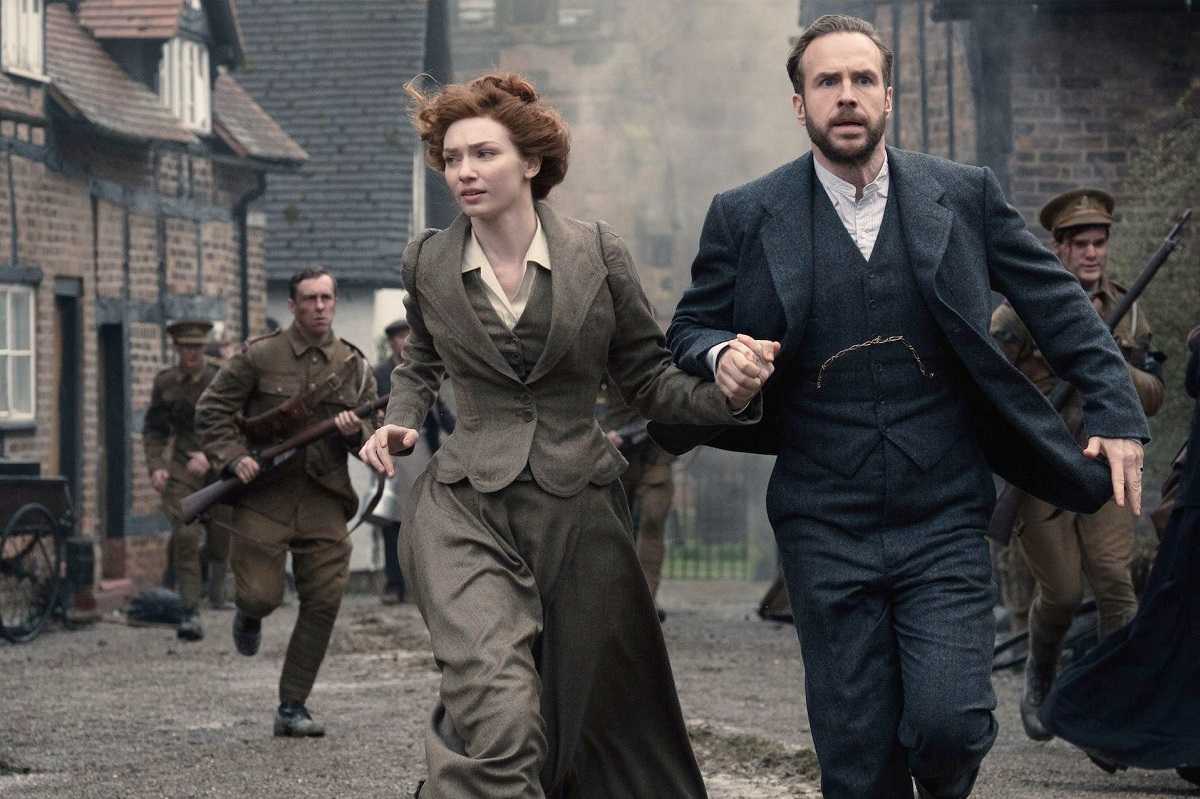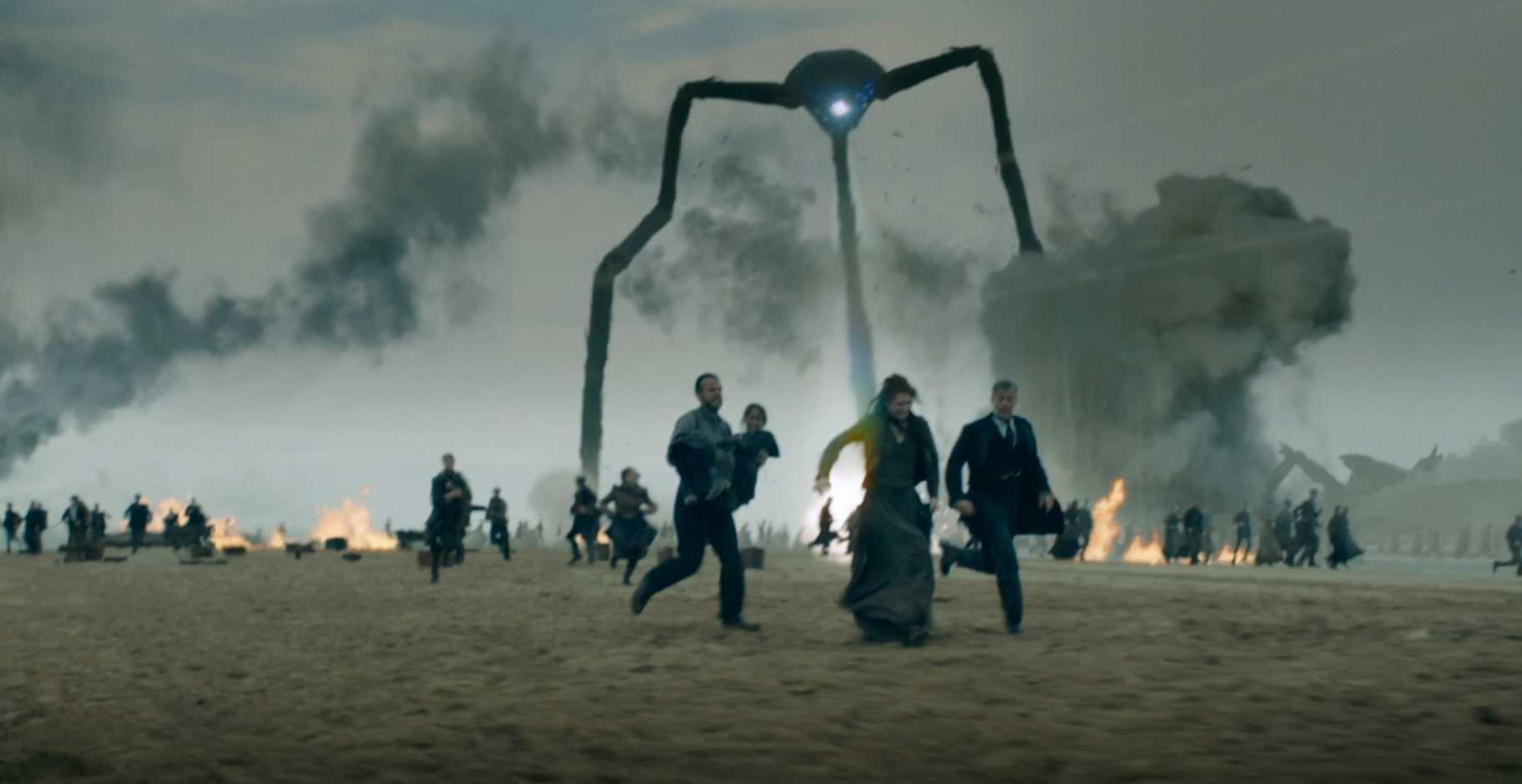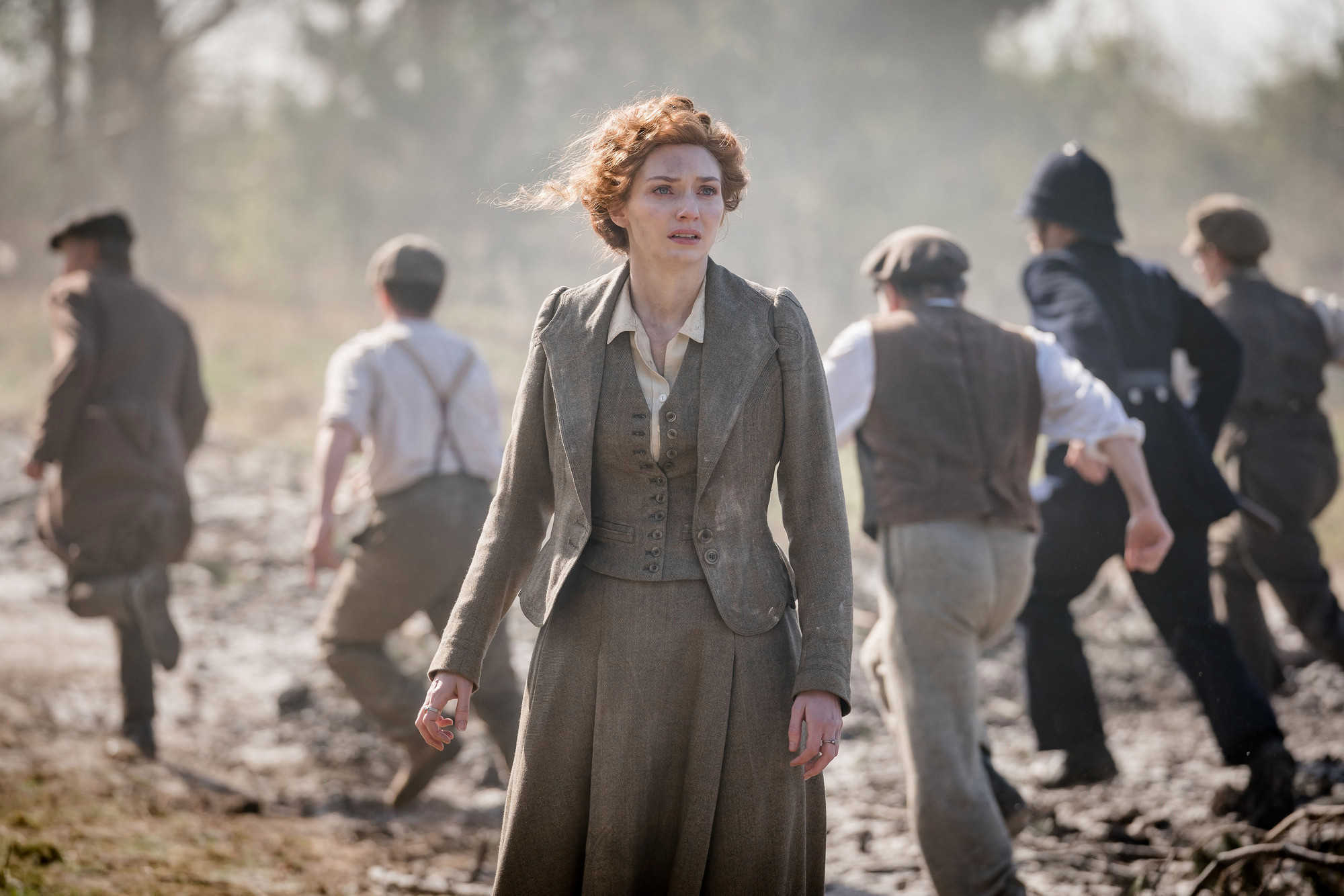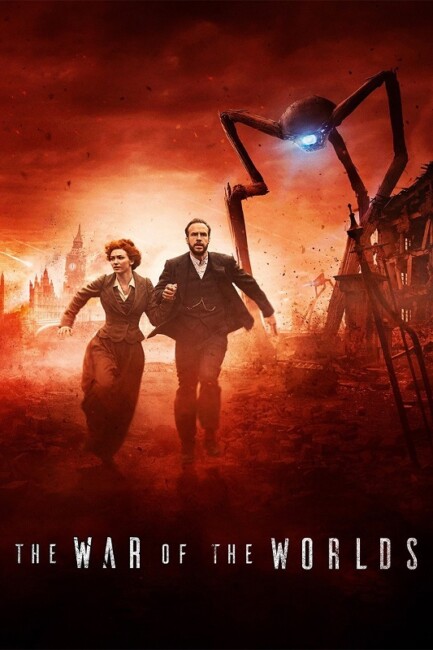UK. 2019.
Crew
Director – Craig Viveiros, Teleplay – Peter Harness, Based on the Novel by H.G. Wells, Producer – Betsan Morris Evans, Photography – James Friend, Music – Russ Davies, Visual Effects Supervisor – Stephen Coren, Visual Effects – IMG VFX & Realtime UK, Special Effects Supervisor – Chris Reynolds, Production Design – Pat Campbell. Production Company – Mammoth Screen/Creasun Media/Red Square TV.
Cast
Eleanor Tomlinson (Amy), Rafe Spall (George), Rupert Graves (Frederick), Robert Carlyle (Ogilvy), Woody Norman (George Junior), Harry Melling (Artilleryman), Jonathan Aris (Priest), Nicholas Le Prevost (Chamberlain), Susan Wooldridge (Mrs Elphinstone), Charlie De’Ath (Greaves), Daniel Cerqueira (Stent), Taliyah Blair (Lilian), Aisling Jarrett-Gavin (Lucy)
Plot
1905 in Woking, near London, England. George has defied the convention of the day by leaving his wife Lucy to move in with Amy who is now expecting a baby. George is struggling to make ends meet as a journalist without much success. Amy works as an assistant to the astronomer Ogilvy and through his telescope observes a series of explosions from the surface of Mars. One of the objects from Mars comes down on Horsell Common. George, Amy and Ogilvy go to observe and see a sphere that floats up into the air and then disintegrates everybody in the near vicinity. As giant tripod machines emerge and begin blasting everything with a heat ray, George and Amy are separated. They try to find one another through the mass devastation as the invading Martians bring the country to its knees.
H.G. Wells’ The War of the Worlds (1898) is a landmark novel. It was the very first alien invasion story. Wells created a series of indelible images imagery of giant Martian tripod machines striding across the landscape in a wake of destruction, bringing sleepy England and the might of the British Empire to its knees. It is to Wells that every alien invasion story owes its ancestry.
The War of the Worlds has appeared in the media a number of times. The first of these was Orson Welles’ infamous 1938 radio broadcast that was presented as an actual live news broadcast and thought to be real by some people. The first of the film versions was George Pal’s production of The War of the Worlds (1953), which kicked the great alien invaders era of the 1950s into high gear, although Pal altered Wells in many ways, removing the tripod machines and updating the setting to contemporary California. Surprisingly, the idea of a revival never took off in the post-Star Wars (1977) era, although there were offshoots such as Jeff Wayne’s best-selling LP The War of the Worlds (1978) and the tv series War of the Worlds (1988-90), which posed as a sequel to the Pal film but radically changed things including turning the invaders into body snatchers.
That was it for many years apart from assorted book and comic-book pastiches. 2005 then saw a sudden renewed explosion of interest. This was prompted by Steven Spielberg’s contemporary reimagining War of the Worlds (2005) starring Tom Cruise. Popping up at the same time was The Asylum’s low-budget but not uninteresting contemporary-set mockbuster War of the Worlds (2005) starring C. Thomas Howell, which later spawned a sequel War of the Worlds 2: The Next Wave (2008), and the even lower-budget The War of the Worlds (2005) from Timothy Hines, which was set during the Victorian era. There have been sporadic other related efforts since then with War of the Worlds: Goliath (2012), an animated film set in an alternate history 1914 with Steampunk mecha taking on a second Martian invasion, and The Great Martian War: 1913-1917 (2017), which rewrites the story as an alternate history retelling of World War I incorporating digitally created war machines into actual WWI footage. The late 2010s saw a new interest again with this version, as well as War of the Worlds (2019-), a tv series that relocates action to the contemporary European Union; The Asylum’s modernised Alien Conquest (2021); and the contemporary Young Adult film War of the Worlds: The Attack (2023).
This version was made for the BBC in three one-hour episodes. It is directed by Craig Viveiros who has made several other high-profile British tv mini-series with the Agatha Christie adaptation And Then There Were None (2015) and Rillington Place (2016). The script is adapted by playwright Peter Harness who has written other tv work such as Wallander (2008-16), the fine alternate reality magic series Jonathan Strange & Mr. Norrell (2015) and episodes of Doctor Who (2005- ).

The BBC made some mutterings about setting out to film the H.G. Wells novel as written, although in this regard the results are very mixed. Certainly, the mini-series restores the Victorian setting that most of the other film versions abandon, has tripod war machines and retains Mars as the aliens’ origin place (which several of the modernised versions have excised because it is no longer scientifically believable that aliens come from there). The Red Weed, an aspect that is dropped by most film versions, get far more prominence here than in the book and we do actually get to see Martians drinking human blood this time. On the other hand, there are a great many other changes that also make this the most variant and radical of the adaptations to date.
The claim to setting the story in the Victorian era (although the mini-series for no apparent reason updates its setting to 1905, seven years after the book was written and four years following Queen Victoria’s death) is less a major effort to take everything back to the source material than the mini-series’ makers might think. The period setting was first conducted in the musical version and on film in the Timothy Hines version, which are both much more accurate to the way the book was written. Hines’ disadvantage was that he was an American and shot his show shot using US actors and locations, whereas this is shot in England (not exactly the real Woking and Horsell Common but locations in Liverpool) and uses a British cast.
One of the more unusual touches is that the mini-series attempts to write H.G. Wells in as the central character in all but name. This follows on from The Time Machine (1960), which gave Wells’s unnamed narrator the name of George and included a throwaway shot revealing that he was H. George Wells, and Time After Time (1979), which has Wells build his own time machine and travel into the future to romance Amy Robbins, who was a modern woman. Various other films and tv have followed suit.
Here George is not specifically named Wells but the film borrows from Wells’ biography at multiple points – he married his cousin Isabel but this was an unhappy relationship and he left her for a student Amy Robbins (whom he did later marry); the two lived in a house called Lynton in Woking. Wells did have a brother Frederick, although he was less notable than the high-ranking government official the mini-series depicts him as being. Wells never exactly worked for a newspaper (least of all the one as depicted here, which seems very much styled after the modern cinematic cliches of how a newspaper runs than was the case in the Victorian era) but did submit numerous stories and articles to papers – today he would more correctly be called a freelancer. The mini-series also makes mention of Wells as a socialist of the era.

One commendable thing the mini-series does bring out that no other version has is Wells’s underlying metaphor of the Martian invasion as being about British imperialism being revisited on the country. The character of George’s brother (Rupert Graves) is written in for no other reason than to make pompous pro-imperialist speeches about how they are proud to be British, keeping foreigners out (which cannot help but seem echoes of Brexit Era-UK and a post-Syrian Refugee Crisis European Union) and initially blaming everything on the Russians. Later Rafe Spall gets a speech where he wonders if the Martians are just doing what the British Empire did with their colonies in subjugating the natives and exporting their own world, which is heavy-handed but does hit Wells’ allegory right on the nose. Each of the major filmed versions of the story have updated the underlying allegory for their era – George Pal for a post-World War II USA entering the Atomic Age and the Cold War, Steven Spielberg for the era of the Iraq War. So this is fitting.
On the other hand, there are changes for the sake of changes that often don’t make sense and just blunten your expectations of the book. In the book, the Martian cylinder lands on Horsell Common, creating a crater. Locals and soldiers approach before a heat ray blasts all of them and then the first Martian war machine emerges. It’s a great, powerful scene and all of the film versions have replicated some equivalent of it in one way or another. For some reason, that scene is absent here or changed in ways that alter its dramatic impact. We have a sphere land on the common but after people approach it suddenly levitates in the air and starts spinning. Rather than any heat ray, this spews out some particulate matter that causes everybody in the near vicinity to disintegrate. There are suitably horrific scenes with people running through the woods being crisped but you are left wondering why change the scene and replace it with something confusing to anyone familiar with the book or other films. Certainly, the war machines and heat ray do appear later but there is no scene where we actually see them emerge. The mini-series also ends up being surprisingly low key when it comes to depicting the mass devastation caused by the Martians.
The book is modest sized, just short of 300 pages. The unnamed narrator witnesses the arrival of the Martians and the devastation wrought. Through this, he seeks to be reunited with his wife and journeys across the countryside, encountering various people. The plot is not any more complicated than that – most of the book exists in terms of the vividness of the invasion scenes. For reasons known only to he, Peter Harness seeks to mix-up and rearrange this.
These changes are most evident when it comes to the supporting characters. There are not many in the book and they are all appear drastically changed here. The astronomer Ogilvy is only present at the start of the book but is given a continuing role throughout the show. We do get the artilleryman – a soldier that the narrator meets on the Common and then later during his journey where he outlines a grand scheme of wanting to build a new civilisation underground before the narrator sees he is an ineffectual dreamer, incapable of pulling this off. Here George meets the artilleryman but rather than encounter him later, the artilleryman is disintegrated by the heat ray.
The other character is the curate, a religious minister that the narrator shelters with in the cellar. As a Martian probe enters the cellar, the curate’s fear-filled religious ramblings threaten to give them away and the narrator is forced to kill him. It is Wells effectively demonstrating the uselessness of religion in the face of an overwhelming force majeure. All of the film versions seem to have had issues with the morality of such a scene and either water it down or remove it. This is no different. There is a curate or at least a minister of religion but he only appears in the five years later scenes. He is not exactly maddened in his religious visions but is dogmatic and inflexible in his thinking. There is an equivalent of the cellar scene, although here this becomes an entire building and those huddled there are expanded to include George, Amy, Frederick, an elderly woman and an orphan child. A Martian (as opposed to a probe) enters and attacks the elderly woman who is too ailing for the others to drag her away to where they hide, however there is no question of them having to kill her to stop her giving them away.

I suspect that if the book were filmed as it was written, there would not have been enough material for a three-hour mini-series so you can’t entirely blame the BBC for expanding it. This may well have been one of the reasons that we have parallel storylines and interweaving character paths where George and Amy are separated, go on their own adventures and meet up again. I can’t say I cared too much for these, nevertheless Eleanor Tomlinson is a radiant find and gave the scenes she is in a great deal of life. On the other hand, Rafe Spall is uncommonly subdued – I have seen him do much better work than this – and is almost entirely written out during the third episode.
Part of the choice for this may well be that contemporary audiences require a story that has much stronger representation from women than was the case back in Wells’ time. Almost certainly, this is why the mini-series seems to favour Amy as a character over George. On the opening credits, Eleanor Tomlinson is the first listed and Rafe Spall second. She also gets to narrate the classic opening line from the book “No one would have believed in the last years of the nineteenth century that this world was being watched keenly and closely by intelligences …”
On the other hand, this leads to changes that seem to be the problem that most viewers had with the series. [PLOT SPOILERS]. At the end of the first episode, we get a surprise cliffhanger where the Earth is looking like the Martian surface scoured by red dust before a hooded woman turns and is revealed to be Eleanor Tomlinson. In successive revelations, we find that she has had George’s child who is now around the age of five. This already alters the end of the book even though we do not know how we got there.
[MORE PLOT SPOILERS] The third episode reveals that George became ill by drinking infected water and was left ailing and even rambling. Aware of this, he allowed himself to be killed by the Martian so that she could get away. The irritation of this is that it weakens and then wrecks a character that the story almost demands be the hero. Moreover, as a result of this change, George is sidelined for most of the third episode – all the scenes hiding from the Martians – so that when his sacrifice comes, it is without a sense of tragedy, just an irritating plotting flick of the pen. There seemed no particular reason for it to have to happen, no reason why the two couldn’t have survived and been reunited again.
Wells wrote a great ending where the Martians were brought down by bacteria – “slain by the humblest things that God, in his wisdom, has put upon this earth”. This is replaced by a limp dishrag of a non-ending. We do see the Martians killed by bacteria but now it is as a side effect of their drinking blood and eating human flesh. Wells’ end is replaced by the extended five years later epilogue where the Martians are dead but the Earth still under the influence of the Red Weed. Robert Carlyle synthesizes an antidote that might be able to kill the Red Weed and the series goes out with a vague hopefulness as Eleanor Tomlinson stares up as the sky just as the clouds clear to show sunlight. It is a heavily disappointing comedown that replaces Wells’ triumphal ending with something that instead tapers off into irresolution. My viewing companion throughout (who had not read the book) summed it up with a puzzled expostulation of “Is that it?”
Trailer here


